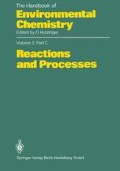Abstract
Recently, the fugacity concept has been introduced and used to model the fate of chemicals which may be accidentally or deliberately released into the environment [1–3]. Its application to environmental fate determinations of toxic substances results in simplified equations for partitioning, transport, and reaction processes and their assembly into a coherent model. Expressing the distribution of contaminants in the environment in terms of fugacity rather than concentration facilitates interpretation of the dynamic processes to which the substances are subject.
Access this chapter
Tax calculation will be finalised at checkout
Purchases are for personal use only
Preview
Unable to display preview. Download preview PDF.
References
Mackay D.: Finding fugacity feasible. Environ. Sci. & Technol. 13, 1218 (1979)
Mackay, D., Paterson, S.: Calculating fugacity. Environ. Sci. & Technol. 15(9), 1006–1014 (1981)
Mackay, D., Paterson, S.: Fugacity revisited. Environ. Sci. & Technol. 16, 654–660 (1982)
Lewis, G.N.: The law of physico-chemical change. Daedalus, Proc. Am. Acad. 37, 49 (1901)
Prausnitz, J.M.: Molecular thermodynamics of fluid phase equilibrium. Prentice Hall, Englewood Cliffs, N.J. (1973)
Van Ness, H.C., Abbott, M.M.: Classical thermodynamics of non electrolyte solutions. McGraw Hill (1982)
Mackay, D., Bobra, A., Chan, D., Shiu, W.Y.: Vapor pressure correlations for low volatility environmental chemicals. Environ. Sci. & Technol. 16, 645–649 (1982)
Mackay, D., Bobra, A., Shiu, W.Y.: Relationships between aqueous solubility and octanol-water partition coefficients. Chemosphere 9, 701–711 (1980)
Mackay, D.: Correlation of bioconcentration factors. Environ. Sci. & Technol. 16, 274–278 (1982)
Karickhoff, S.W.: Semi-empirical estimation of sorption of hydrophobic pollutants on natural sediments and soils. Chemosphere 10, 833–849 (1981)
Baughman, G.L., Lassiter, R.R.: In: Estimating the hazard of chemical substances to aquatic life. ASTM Tech. Pub. 657, Cairns, J. Jr., Dickson, K.G., Maki, A.W., Eds. 35 (1978)
Burns, L.A., Cline, D.M., Lassiter, R.R.: Exposure analysis modeling system (EXAMS): User manual and system documentation. U.S. EPA Environmental Research Laboratory, Athens, GA(1981)
Smith, J.H., Mabey, W.R., Bohonos, N., Holt, B.R., Lee, S.S., Chou, T.-W., Bomberger, D.C., Mill, T.: Environmental pathways of selected chemicals in freshwater systems, Vol. II, EPA-600/7-78-074 (1978)
Neely, W.B., Mackay, D.: In: Modelling the fate of chemicals in the aquatic environment, Dickson, K.L., Maki, A.W., Cairns, J. (eds). Ann Arbor Science, Ann Arbor, MI. 127 (1982)
Schmidt-Bleek, F., Haberland, W., Klein, A.W., Caroli, S.: Steps towards environmental haward assessment of new chemicals (including a hazard ranking scheme, based on directive 79/831/EEC). Chemosphere 11, 383 (1982)
Hushon, J.M., Klein, A.W., Strachan, W.J.M., Schmidt-Bleek, F.: Use of OECD premarket data in environmental exposure analysis for new chemicals. Chemosphere 12, 887 (1983)
Georgopoulos, P.G., Seinfeld, J.H.: Statistical distributions of air pollutant concentration. Environ. Sci. & Technol. 7, 401A (1982)
Dean, R.B.: In: Chemistry in water reuse, W.J. Cooper (ed). Ann Arbor Science, Ann Arbor, MI (1981)
Mackay, D., Paterson, S.: Spatial concentration distributions. Environ. Sci. & Technol. 18, 207A(1984)
Hahn, G.J., Shapiro, S.S.: Statistical models in engineering. J. Wiley & Sons, Inc. (1967)
Aitchison, J., Brown, J.A.C.: The lognormal distribution. Cambridge University Press (1966)
Weibull, W.: A statistical distribution function of wide applicability, presented to the American society of mechanical engineers. Atlantic City, N.J. (1951)
Mackay, D., Joy, M, Paterson, S.: A quantitative water, air, sediment interaction (QWASI) fugacity model for describing the fate of chemicals in lakes. Chemosphere 12, 981–997 (1983)
Mackay, D., Paterson, S., Joy, M.: A quantitative water, air, sediment interaction (QWASI) fugacity model for describing the fate of chemicals in rivers. Chemosphere 12, 1193–1208 (1983)
Rosenblatt, D.H., Dacre, J.C., Cogley, D.R.: In: Environmental risk analysis for chemicals, Conway, R.J., ed. Van Nostrand Reinhold, New York, 474 (1980)
Author information
Authors and Affiliations
Rights and permissions
Copyright information
© 1985 Springer-Verlag Berlin Heidelberg
About this chapter
Cite this chapter
Paterson, S., Mackay, D. (1985). The Fugacity Concept in Environmental Modelling. In: Reactions and Processes. The Handbook of Environmental Chemistry, vol 2 / 2C. Springer, Berlin, Heidelberg. https://doi.org/10.1007/978-3-540-39048-0_4
Download citation
DOI: https://doi.org/10.1007/978-3-540-39048-0_4
Publisher Name: Springer, Berlin, Heidelberg
Print ISBN: 978-3-662-15261-4
Online ISBN: 978-3-540-39048-0
eBook Packages: Springer Book Archive

